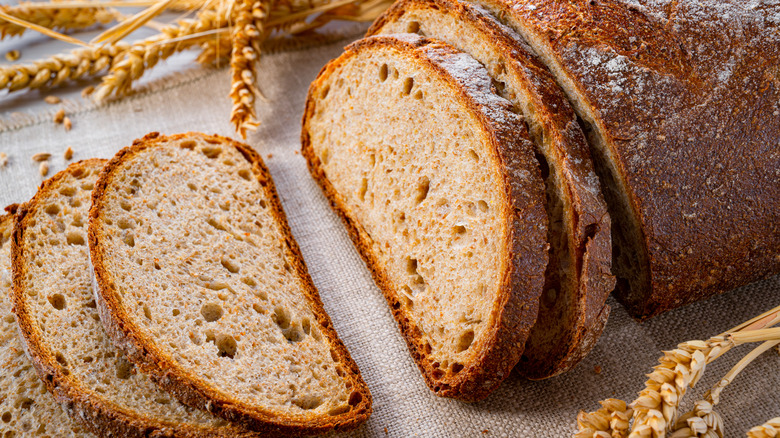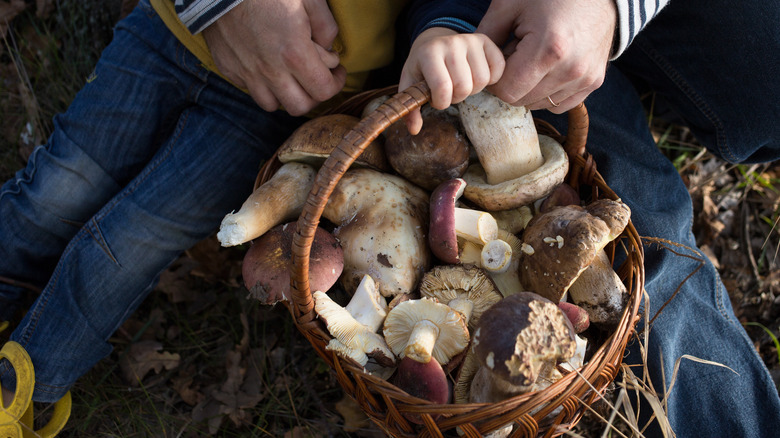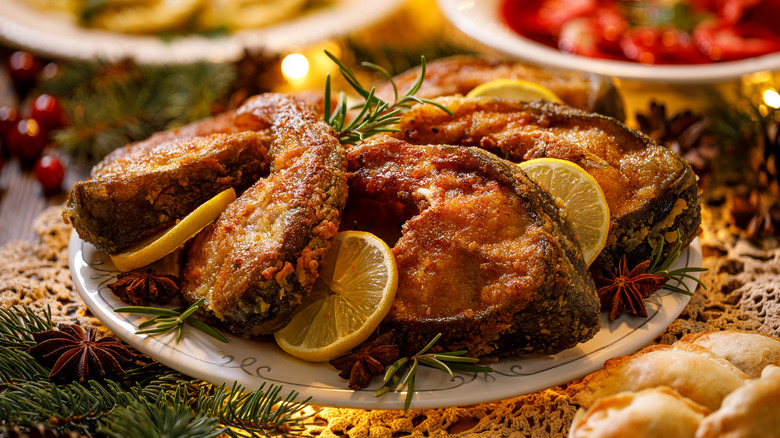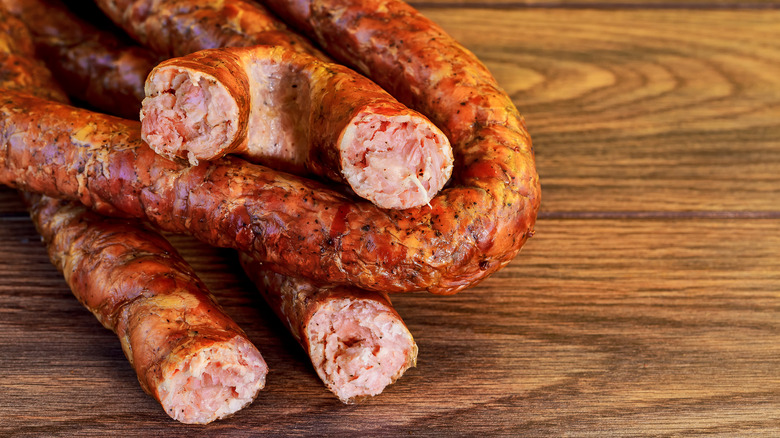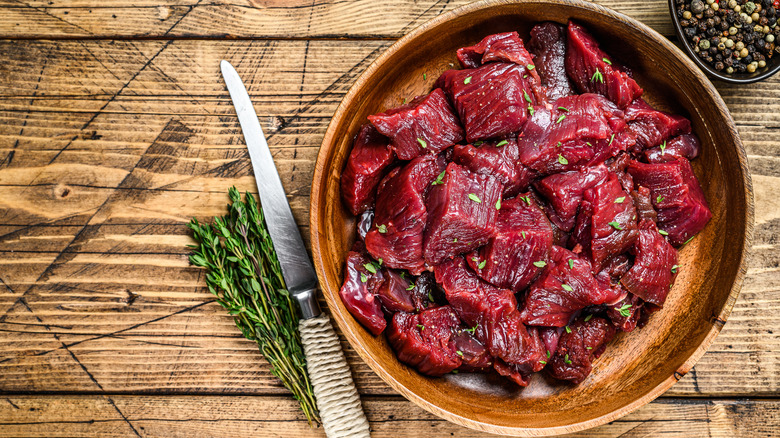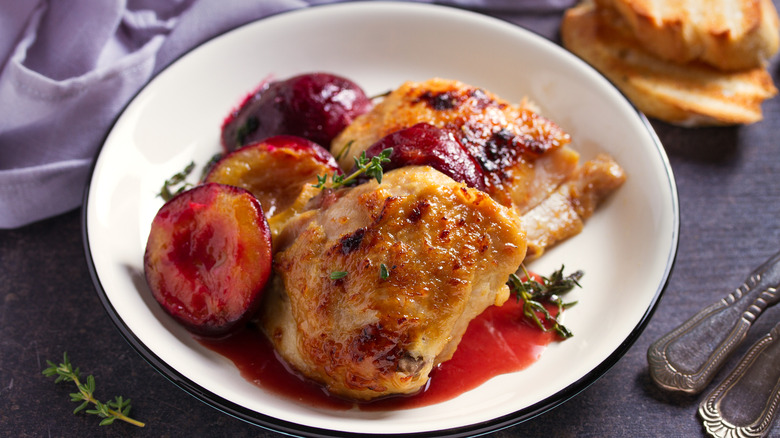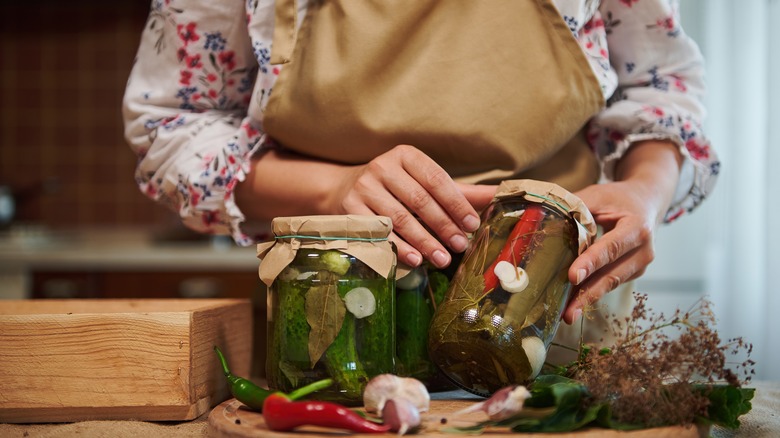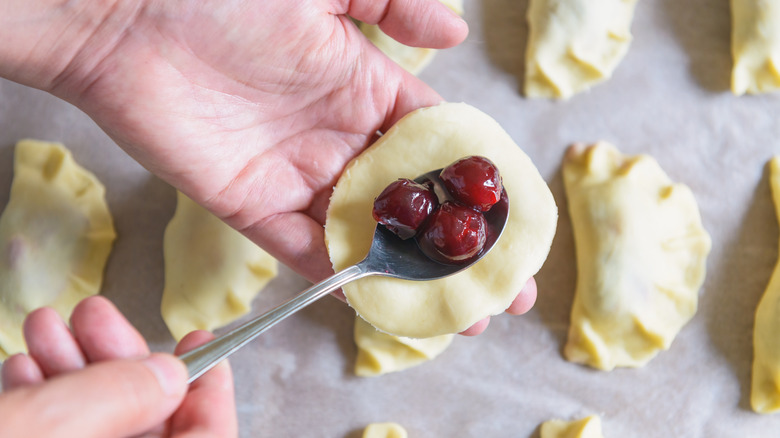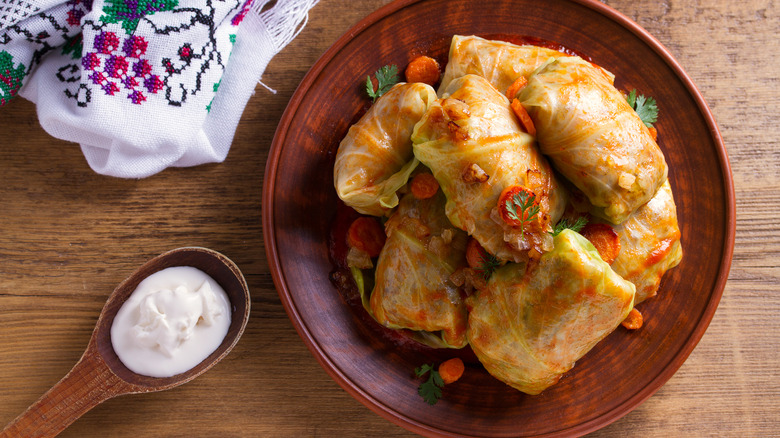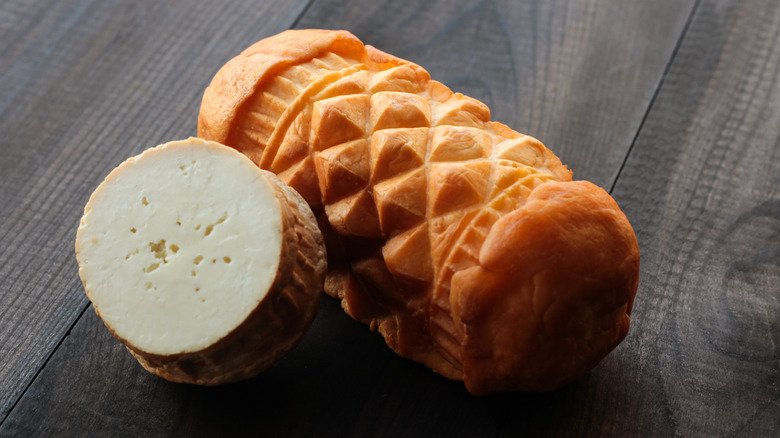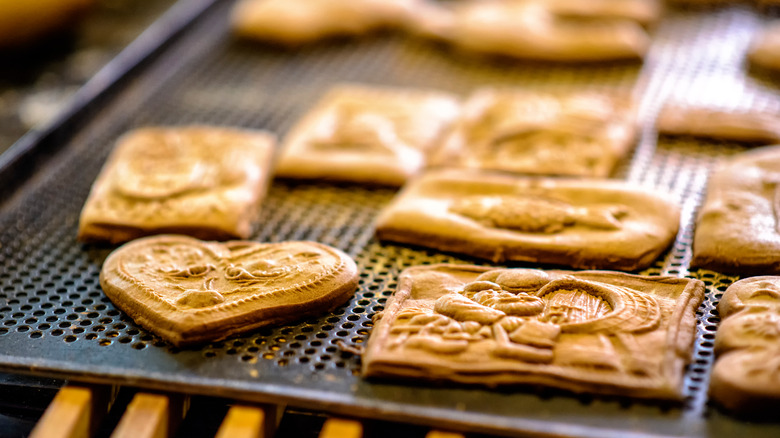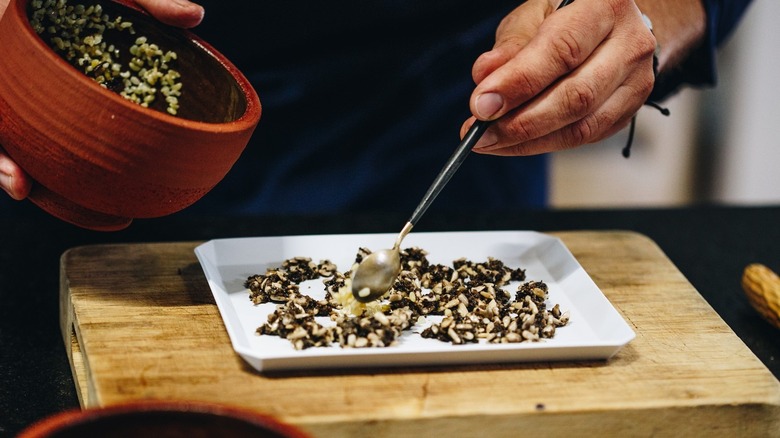Everything You Need To Know About Polish Food (And What You Need To Try First)
Poland is a country of vast landscapes and forests, offering an endless diversity of wild foods and agricultural products. It is also considered one of the leading food exporters in Europe (per U.S. Department of Agriculture) and continues to gain recognition globally as a country of rich cuisine and contrasting flavors. History has tested Poland's ability to prevail over the course of multiple wars and oppression by the Soviet Union — all of which have had an influence on Polish food. Despite the ever-changing cultural borders, Poland has maintained its strong identity while also including foreign customs in the local cuisine.
If you ever get the chance to taste Poland, you'll be met with a colorful display of strange-sounding dishes, as well as the world-famous Polish specialties you'll be dying to try immediately. You might also have the chance to participate in communal culinary traditions, such as foraging for mushrooms and eating special meals on religious holidays. Make sure you leave some room for dessert!
Poles love bread
Poland is a country where bread holds a significant religious and cultural meaning. For centuries, Polish bread has been celebrated with the utmost respect; some bakers to this day score a symbolic cross on the bread before serving, and, for important occasions, the bread is often used as an offering. In some Polish households, if a piece of bread would end up on the floor, it would be usually picked up and kissed — a beautiful act of appreciation.
Probably the best-known variety of Polish bread is rye sourdough. Mostly distinguished as a dark and rich loaf, it's a type of bread that has become synonymous with Polish cuisine. The sourdough rye bread may be more common today, but back in the 17th century, French diplomats were rather confused by it, thinking it was an insult when dark bread was offered to them by the Polish.
Since the beginning of the 90s, the start of the post-communist era in Poland, bread production has been highly commercialized, leaving a handful of artisanal bakeries to preserve traditional methods of bread making. One such bakery in Warsaw, RDEST, is also known to serve kvas, a fermented bread drink made out of leftover rye bread and honey. If you ever want to try an authentic Polish loaf, chances are you can — just follow the footstep of Polish ex-pats.
Polish cuisine explores the tastes of the wilderness
Wild foraging in the West usually means attending a weekend course to learn all about the local edible plant species, but not in Poland. According to New York University professor Fabio Parasecoli, wild food collecting is an important part of Polish cuisine and culture (via HuffPost). From berries, honey, herbs, and mushrooms, Poland's natural diversity offers an incredibly rich collection of wild edibles.
While berries and various medicinal herbs are often used to make Polish nalewki, artisanal spirit infusions that you can find at the local market or food festivals such as Festival of Taste, wild mushroom picking is a nationwide recreational activity. Each year, when the mushroom season begins in September, flocks of Poles, young and old, graze through forests looking for local delicacies such as porcini, chanterelle, milk caps, and many other less-known varieties of wild mushrooms.
Researchers R. Gordon Wasson and Valentina Pavlovna Wasson once described Poles as "mycophilic" — a word that refers to the love of mushrooms (per Culture.pl). When you see the scope of recipes featuring wild mushrooms in Poland, it's fair to say they were right. However, although Poles are most likely better at identifying wild mushroom species than westerners, mushrooms are still often feared and mystified. Nevertheless, wild foraging remains at the heart of Polish food culture, and it's something we'd love to savor at the first opportunity.
Fish is the star of the festive season
Fish has played a very important role in Polish cuisine due to the religious fasting tradition. But one fish has earned a special place at the Polish table, ultimately becoming a symbol of Christmas Eve — and that is carp. Authentic holiday carp preparation has roots dating back to the 17th century and has remained mostly untouched to this day.
Traditionally, carp was always prepared as a boneless fish, filled with raisins and seasoned with exotic spices from Asia. The Poles have always been very fond of imported spices, particularly ginger, clove, saffron, and cinnamon, and were never scared to experiment with them. We can find old references to fish recipes that implement the use of sweet berries, vinegar, beetroot, and hot spices — a novel practice in Europe even today.
An interesting fact about the famous Christmas Eve dish is that carp are meant to be kept alive for a couple of days, usually in a bathtub. The tradition is still widely popular in Poland and neighboring Slavic countries. Although not proven to be effective, it was meant to clean the carp of excessive mud. It sure sounds like a lot of fun trying to tackle one of those strong fish before cooking.
Poland is a sausage lover's paradise
One specialty food that made Poland famous abroad is sausage. The first original Polish kielbasa (which translates to sausage in Polish) was mentioned around the 18th century; a combination of wild game and pork, deeply smoked and often made into a long rope, sausage was a treat of the upper classes. Although we aren't going to see a lord carrying one of those around on their belt these days, the word kielbasa has become a household name for most sausages coming out of Poland.
A country largely responsible for the fame of Polish sausages is Lithuania. This territory, once a part of Poland, is well-known for outstanding dried and smoked sausages with a distinct juniper aroma. Poland to this day has a large variety of cured sausages and while most of the meat processing has been largely industrialized to contain multiple additives, dried and smoked sausages remain a beautiful natural alternative as they don't require additional preservatives to maintain their two-year-long shelf life.
Polish kielbasa has successfully jumped over the Atlantic and today is often found at favorite hot dog stands in the US. If you haven't tried it yet, be sure to check out the Original Maxwell Street Polish Sausage Sandwich, at Jim's Original in Chicago.
Wild game is still popular in Poland
Poland is Europe's leading hunting hub and due to its large state-owned forested area, most of Poland's wildlife has been carefully preserved (via Zenodo). Wild game population management allows for a number of animals to be hunted each year offering foreign hunting enthusiasts an opportunity to experience pristine Polish landscapes and forests with most of its animals like elk, deer, boars, hares, and partridges still living in their natural habitat.
As two Chicago-based Polish ex-pats, Joseph Zurawski, a Polish historian, and Julita Siegala, a photo archivist at the Polish Museum of America, explained to Chicago Tribune, the wild game has always been an elaborate part of Polish cuisine. Among the rustic dumplings and stews, you can find a beautiful "tenderloin venison" and "hare in sour cream and caramel sauce," exemplifying the between simple Polish cooking and the cuisine dedicated to the upper class.
Today, to try wild game dishes in Poland you do not have to be a nobleman, as a number of restaurants offer a taste of original Polish cuisine, including one of Warsaw's favorite spots, Przy Zamku. The restaurant has a review on TripAdvisor that screams: "Wild game everywhere." While it may be a happy exaggeration, Poland is definitely a place where you can taste wild meat and leave your heels and tuxedos behind.
Goose is a traditional holiday treat
The Polish nation seems to have a dish for any occasion. Each year on November 11th, St. Martin's day, the traditional Polish goose is served all across the restaurants and households in Poland. The story tells of a Hungarian-born Bishop Marcin of Tours in France, who tried to escape his ordination, too humble to accept the title, and was eventually found hiding among the geese. Since then, St. Martin's day as we know it today has been celebrated each year, and the goose has become a central dish for the occasion.
As of 1918, November 11th had become a day marking Polish Independence, and the goose now serves as a symbol of freedom. Although Poles rarely consume this beautiful bird the rest of the year, as Akademia Restauracja explains, most of the goose raised in Poland ends up on the table in Germany, where Polnische gans (Polish goose in German) is a very popular delicacy the year round.
The Polish have an acquired taste for sour foods
Poles do love a good pickle! The taste for sour foods may have started out of the need to preserve vegetables during the cold winter months, but it has become a masterful art of pickling, which Poland is famous for today.
Probably the most important of all the pickles are the kruszewskie cucumbers that Culture.pl dubbed "the Rolls-Royce of the cucumber world." Grown in the Kruszewo village, the famous cucumbers have been originally prepared in barrels and stored in a river till spring, a sight that received credit from Napoleon himself during his journey towards Moscow. Most cucumbers in Poland are pickled with dill, horseradish, cherry, and grape leaves, and seasoned with spices like mustard seeds and tarragon, giving the pickles a distinctively Polish taste and aroma.
Besides cucumbers, there are more interesting pickles and ferments in Poland such as beetroot leaven, or soured rye. Both the beetroot and rye are prepared in a similar way and later used as a base for Polish borscht soup. It packs much more acidity than traditional Russian borscht, and it is considered a national dish. It's very common for most Polish households to have this fermented liquid ready at all times, so if you come to visit someone in Poland, chances are you will be served a bowl of classic red soup.
Poland is the land of dumplings
It may be hard to believe, but the dish that has put Poland on the culinary map is a humble dumpling. Pierogi (a classic Polish dumpling) has been on the menu in Poland since the 17th century and today is a comfort food enjoyed all around the globe. From London to Shanghai, Poles can find their beloved dumplings wherever they go. To add to the iconic status of the dish, the Canadian town of Alberta has built a huge statue in the shape of the dumpling. Although the initial design has left the townspeople puzzled, an additional fork has been built to pierce the dumpling — a wonderful expression of love for the pierogi.
Making pierogi is a time-consuming labor, but if you want to appreciate a truly authentic dumpling, it has to be made fresh and there are no timesaving tips to help you along the way. The dough for pierogi is usually made out of flour, water, egg yolks, and oil. Once the dough is kneaded, rolled, and cut into rounds, it is ready to be filled with a variety of things — cheese, potatoes, mushrooms, and sauerkraut are the most popular flings. Nonetheless, some Polish chefs have taken on a challenge to elevate the symbol of Polish cuisine to the next level: Warsaw's restaurant Elixir serves beautiful parcels filled with roasted beetroot and caramelized cranberries — a heavenly-sounding treat.
Poles find creative ways to use cabbage
Cabbage has always been slightly under-appreciated, but it is in fact a very nutritious vegetable. Cabbage is rich in vitamin C, potassium, and magnesium, and has a generous amount of fiber, making it a great aid for digestion (per WebMD). It's super cheap as well, so adding this leafy vegetable to your next shopping basket won't break the bank. But what to really do with it? Well, the Polish seem to know.
The idea of stuffing leafy vegetables isn't new; we are probably familiar with traditional Greek dolmades, grape leaves filled with beef and rice. But have you ever heard of a Polish gołąbki — cabbage rolls stuffed with minced pork and rice, served in a rich tomato gravy? Gołąbki in Polish literally means pigeon, but there's no bird involved, promise. It's a beloved comfort food in Poland, and often consumed for special occasions — probably because it really takes some effort to make them.
Bigos, sometimes called "hunters stew," is another cabbage dish loved in Poland. Before it became known as a smoky pork stew with cabbage and sauerkraut, it has undergone an unusual transformation. At the end of the 18th century, Polish suddenly decided to turn to local ingredients, abandoning French influences, and bigos, a meat and fish stew that once was flavored with wine vinegar, wine, or unripe grape juice, has become a simplified meal for the common folk: A hearty sour cabbage stew.
Poles make a rare, beautiful sheep's milk cheese
It would be hard to find a country without a unique cheese-making culture, but Polish smoked sheep milk cheese — or, oscypek — is worth a special feature. This beautifully decorated cheese from the Podhale mountain region is intriguing, at the very least. According to BBC Travel, the origins of oscypek date back to the 13th century and are synonymous with the arrival of the Balkan tribe Vlachs to the region. The cheese is still made in the area today.
Making oscypek definitely requires knowledge and experience, which bacas (local shepherds and cheese masters) have passed from generation to generation. The ancient smoked cheese is made from no less than 60% of sheep milk and is shaped in decorative sycamore molds, per BBC Travel. The beautiful molds once served a double purpose: Spindle-shaped cheese was traded as a form of currency as well as a courtesy to churches and the King's Court.
If you ever get a chance to travel to the Podhale region in Poland, oscypek is truly a wonderful souvenir to take home — that is, if you can find a genuine cheese. Due to strict EU regulations, it has become more difficult to find an authentic version of this smoky delicacy in Poland, so keep your eyes peeled for a Protected Designation of Origin label. Although the best bet would be to go see the local cheesemakers – after all, each baca adds his own unique spin on it.
Fat Thursday is dedicated to eating sweets
We love food traditions, especially the ones that involve eating a dessert. Luckily for us, Poland has a special day called "Fat Thursday" — a day of mindless doughnut eating just before the Lent period around February each year. Millions of gorgeous jam and cream-filled doughnuts called pączki in Polish are consumed in a matter of a day, with people sometimes queuing for hours just to get a bite of one.
Although the origins of this tradition are entirely religious (the last opportunity to feast before the 40-day fast), Poles have made it a fun day for the whole family; all the kids must be squeaking with impatience before the sweets-filled "Fat Thursday" of each year. If you like donuts as much as we do, you should check out a Polish bakery on the holiday, as Polish ex-pats celebrate "Fat Thursday" in the US as well.
Toruń, Poland is famous for its gingerbread
The city of Toruń in Poland is best known for being home to an iconic Polish treat gingerbread. The roots of this national treasure date back to the 13th century, when Toruń played an important role in the spice trade with the east. Polish love for oriental spices has led to the creation of the centuries-long tradition of baking gingerbread in the region. Wheat flour and honey were produced locally in Toruń, making it an ideal place to start a gingerbread empire that is hundreds of years old today.
In 2015, a museum was opened in Toruń dedicated to the cultural heritage of this famous Polish biscuit. The museum was built on the grounds of the legendary gingerbread factory dating back to the 19th century. The modern factory still operates today, but guests can take a stroll through the old factory building and taste the traditional gingerbread that is still produced using the same old recipe. It's also a great place to see all the vintage molds that were once used to cut biscuits, which depict Polish royals and other famous people in Poland.
Modern Polish cuisine is making its global mark
A great way to experience the finest of Polish cuisine is to dine with Poland's most decorated chef, Wojciech Modest Amaro. Wojciech has trained with the world's best, including Ferrer Adria at his famous El Bulli in Catalonia, Spain. Inspired by the modernist movement, chef Amaro turned back to his Polish roots and opened Atelier Amaro in Warsaw — the first ever restaurant in Poland to receive a Micheline star. The restaurant never had a usual menu and was a serving experience that would shift every day to represent the ever-changing seasons in Poland.
Although Atelier Amaro is no longer open, Wojciech continues to share his lifelong dedication to fine food via his new passion project, Farm Dining. Chef Amaro invites guests to his private farm estate where he offers an intimate farm-to-table experience. Seats at Farm Dining are very limited, with only 12 diners lucky enough to enjoy Wojciech's carefully crafted seasonal menu. It's a must-visit while in Poland, but you should definitely book in advance!

